I had described my sailing adventures to Doug Macauley a few times, and he
mentioned his own sailing adventures, including taking lessons and racing on the
Hudson River. I always enjoy taking a new sailing enthusiast on one of our trips
to Maine. The sailing challenges, the beautiful seacoast, and the good sailing
weather in spring are an almost unbeatable combination. Doug's good cheer only
added to our fun.
The first day, from Camden to Seal Bay on Vinalhaven, was about as good a day
of sailing as you can have. We sailed the entire way, using the spinnaker in a
gentle morning northwesterly, then sailing all the way through Hurricane Sound
and the Fox Island Thorofare in a brisk southwesterly under full main and
our 130 heads'l. Finally, we hardened up at the exit to make our way around the
headlands on the northeast side of Vinalhaven to the entrance to Seal Bay, one
of my favorite spots in Maine.
On the second day, we crossed to Isle Au Haut, an island I've wanted to visit
for years. One year we were planning to visit and were frustrated when we
unexpectedly had to refill our propane tank. We were forced to go to Stonington
on Deer Island, where we begged a passing van driver who turned out to be Milly
Lawry, a local resident and a sweet lady with a great sense of humor, to give us
a ride to the propane station. Since then, we focused more on northern Maine and
Nova Scotia, and had no opportunities to make it to Isle Au Haut.
We anchored in Duck Harbor, a bit of a difficult spot with somewhat
questionable holding ground and too open to westerlies. However, we got
ourselves well nestled in, and the winds appeared mild and far enough south to
allow us a few hours of hiking. We landed the P. Ellen and headed out for a very
long and strenuous hike to the top of Duck Mountain and almost all the way to
the southeastern shore. We were too ambitious, we discovered, in thinking we
could go to southeastern shore and then back along the southern cliff trail. We
wouldn't have returned to the boat for several more hours. So, we headed back
before conditions changed in the anchorage, but not before having lunch
overlooking the Atlantic high up on some rocky cliffs.
We sailed away from Duck Harbor for what should have been an easy sail to
Frenchboro, Long Island. We put up the spinnaker as we turned down Merchant Row.
As the winds freshened in the late afternoon, Michael and I discussed the
question of how strong we should allow the winds to get before dousing the
spinnaker. Michael wanted to go to 19 knots. I remembered out loud how difficult
the takedown had been in previous 19 knot plus situations, and we agreed to
snuff the chute on the first reading of 18 knots of wind speed on the
anemometer.
Michael was surprised when I rushed forward the minute we clocked 18 knots of
wind speed. The wind very quickly started gusting up to about 22 knots, and we
were facing that difficult spinnaker takedown situation I had been hoping to
avoid. I was having trouble keeping the sail from filling back up as we pulled
the sock down. I was trying to explain to Doug that he needed to ease the sheet
further as the sock came down. We had several cycles of dropping the sock half
or two thirds only to have it fill back up and feel the boat rush forward and
heal way over, as we were pointed somewhat too far into the wind because of
trying to luff the sail during the collapsing phase. Finally, Doug and Michael
figured out what was happening, eased the sheet more, and Doug ran forward to
help me pull the sock down the final 15 feet, an enormous help. I later found a
large blister had formed and ripped off of my middle finger where I had been
pulling on the control lines for the sock. This wasn't the demonstration of
spinnaker techniques I was hoping for with our new sailor, Doug, on board.
Since then, I've gone on the internet reading about spinnaker takedown
techniques looking for some wisdom on dousing spinnakers when the wind is
stronger. I read about a method I've used twice now successfully but still
haven't tried in higher winds. You ease the downhaul after releasing the collar
that attaches the tack to the headstay. Then, as the sail collapses, you haul
the sheet tight and pull the sock down along the leach of the sail. The benefit
of this method is you don't turn up wind, which is unstable with the spinnaker,
especially if it fills back up in a stronger gusty breeze. Also, the spinnaker
is blanketed by the mainsail, and the apparent wind speed is less. The only
issue is the sock seems to want to come too close to the spreaders on the way
down, even laying against them in some cases. I think this happens because there
is air flow around the forward edge of the mainsail that sucks the sock and the
spinnaker along the mainsail's forward edge, pulling it toward the spreaders.
Turning more downwind with the main properly prevented might alleviate this
problem.
After we managed to drop the spinnaker, we sailed south of Marshall
and north of Black Ledge, the direction favored by the west wind we were
experiencing. Avoiding the ledges required careful navigation, so I went from
fighting the spinnaker to focused atttention on our bearings off of Marshall and
some of the islands nearby.
I was relieved to arrive in Lunt Harbor,
Frenchboro, Long Island and rest from a very busy and physically challenging day
of sailing and hiking. I knew I was tired when the crew of a nearby vessel asked
us where we had come from, and I found myself stuttering trying to remember what
port we had left from that day. Michael ended up answering, and I'm sure they
thought I was unfriendly and unsociable for simply staring at them when they had
tried to engage in a little friendly boat to boat smalltalk.
The next day
morning we went on a hike on Long Island. We found a beautiful trail through an
island wildlife refuge to Eastern Point. We then walked all the way to Rich's
Head, passing a couple of very nice coves, which I thought could make fun
anchorages on a future trip. We couldn't find the trailhead at Rich's Head,
which was indicated on a chart we had. So, we made the famous mistake of
thinking we could bushwhack our way to the trail head and find it easily. We
wandered through the woods for a good half hour before finally happening upon
the trail. We made a very poor choice to turn left, guessing on shadows and some
idea of the winding path's location and our general path through the woods.
After another hour or more we discovered we were on the south side of the
island. We walked another hour to retrace our steps and finally found our way to
the Beaver Pond, and a path leading along the northern side of the island. All
in all, we must have hiked for around five hours on a two mile square island
before finding our way back to the boat. We were all exhausted, and I wondered
if Doug could possibly have considered this part of the trip to be fun. It's
hard to plan the land exploration on these islands, as the information about
trails is sketchy and hard to get in advance.
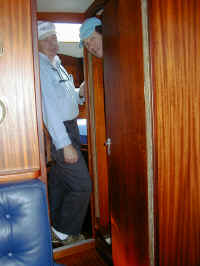 Doug getting a tour of the digs and a how-to on the all-important head.
Doug getting a tour of the digs and a how-to on the all-important head.
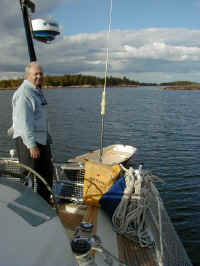
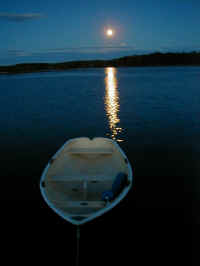 We are rewarded by the beauty and tranquility of Seal Bay.
We are rewarded by the beauty and tranquility of Seal Bay.
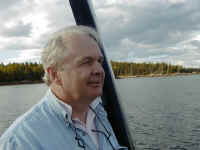
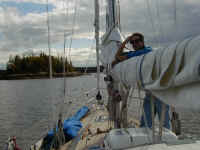
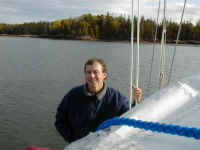
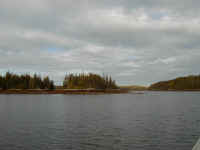
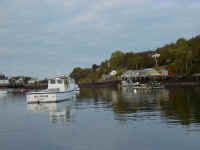
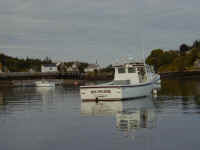
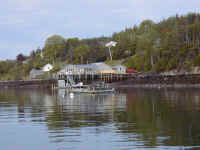
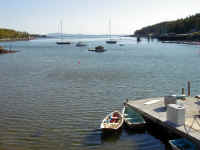
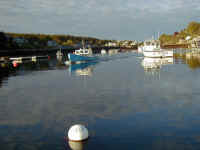
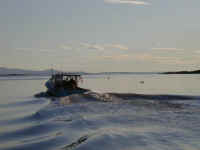
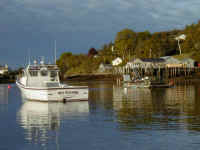
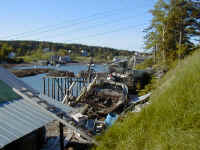
Various
views of Lunt Harbor.
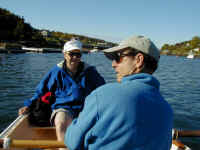
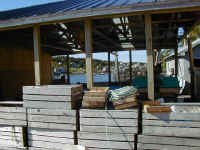
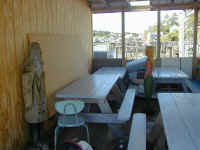
On
our way to a very, very long hike.
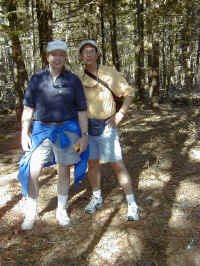
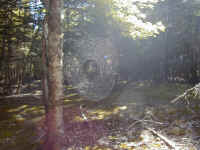 In the enchanted forest.
In the enchanted forest.
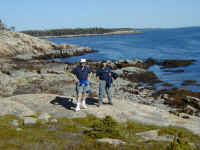 We reach Eastern Point, a short hike so far.
We reach Eastern Point, a short hike so far.
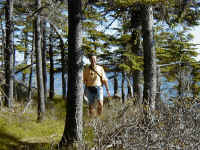
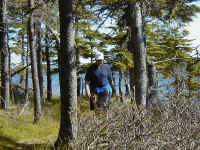 Still in good spirits on the way to Rich's Head.
Still in good spirits on the way to Rich's Head.
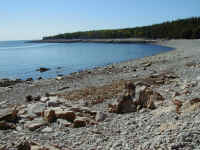
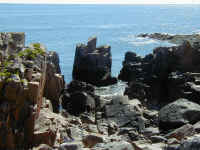 Coves along the way to Rich's Head.
Coves along the way to Rich's Head.
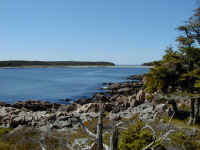 The cove at Rich's Head. Looks like a good anchorage, except for easterlies.
The cove at Rich's Head. Looks like a good anchorage, except for easterlies.
Now
no pictures until we make it back to the innner harbor much, much later...
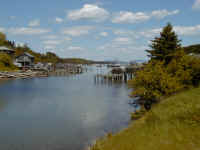
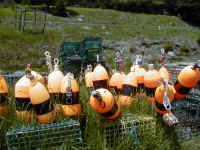 The inner harbor.
The inner harbor.